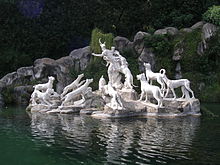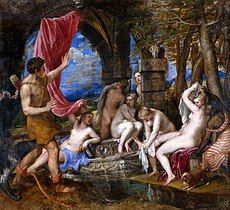Acteon
Actaeon (in ancient Greek Ἀκταίων Aktaiôn) was, in Greek mythology, a famous hunter initiated in this art by the centaur Chiron, also Achilles' teacher. Son of Aristeo and Autonoe of Boeotia, he suffered the wrath of Artemis (Diana, in the case of the romanization of the legend, according to, for example, Ovid's version). The story is also narrated by Hyginus, Pausanias, Euripides, Callimachus, and Aeschylus, among other classical authors.
The myth
Artemis, consecrated to chastity, was bathing naked in the woods near the Boeotian city of Orchomenus, when Actaeon chanced upon her. He stopped and stared at her, entranced by her alienating beauty. As punishment, Artemis changed him into a stag for the desecration of seeing his nakedness and her virginal mysteries, and she sent Actaeon's own hounds, fifty, to kill him. They tore him to pieces and devoured his meat, to later look for his master through the forest, sobbing. So, they found the centaur Chiron, who, to comfort them, built a statue of his deceased owner. According to Ovid's account in The Metamorphoses (book III, 151-252), the goddess was accompanied by her retinue of nymphs. In another version of the legend, Actaeon boasted that he was a better hunter than Artemis, so she turned him into a stag that was eaten by her own hunting dogs. There are parallels between the story of Actaeon and the blindness of Tiresias, who lost his sight as punishment for seeing Athena naked, and between Actaeon and the Chaldean and Phoenician myth of Aqht and the goddess Anat.
The color that usually has the clouds when it hurts the sun in front, or the aurora replenished, is the one that Diana had when she felt naked. Although the multitude of her companions stood around her, she still stood aside, turned her head back, and as she had wanted to have her arrows at hand, she laid hands on what she had, the water, prayed with her the face of the man, and poured out upon her hair the vengeful liquid, and pronounced these words that announced the imminent catastrophe: Now you're allowed to tell that you've seen me naked, if you can count itMetamorphosisOvid.
Artistic representation
There is a krater from the 5th century BC. C. (approximately around 460 BC), which receives the name of Artemis killing Actaeon. The British Museum keeps Hellenic marble reliefs about the myth. In 1684, Marc-Antoine Charpentier set to music a lyrical tragedy that he called Actaeon.
The ancient Diodorus Siculus wrote variations of the story. He was also represented by numerous much later painters, such as Titian, Nicolás Poussin, Parmigianino, Veronese, Rembrandt, Annibale Carracci or Delacroix.
Interpretation
In his work Being and Nothingness, Jean Paul Sartre establishes what he calls the Actaeon complex, which he defines as the physiological and psychosexual order (the curious gaze and lascivious) whose sublimation triggers the stimulus of all search. In this sense, he warns that the investigator is the hunter who surprises passive nudity and violates it with her gaze. Thus, the set of these images reveals the idea of hunting as a symbol of appropriation, as well as sexual desire itself, perhaps even more primitive, since one hunts to eat, to possess. Curiosity, in the animal, is always sexual or alimentary. Curiosity by necessity leads to knowledge. To know is to eat with the eyes.
This metaphor of Actaeon as a hunter passionately pursuing knowledge was already presented in the XVI century by the Italian thinker Giordano Bruno. In his dialogue Los heroicos furores , from 1585, he identified Actaeon with the authentic philosopher who, in his search and contemplation of the truth (Diana), ends up hunted by it and finally reaches the bliss.
The Polish writer naturalized in France, Pierre Klossowski published in 1956 a short novel called Diana's Bath, in which he reflects on the legend.
Acteón in Spanish literature
The Baroque playwright Antonio Mira de Amescua composed his poem in fifty-eight real octaves about the myth Fable of Actaeon and Diana, and already in the XVIII José Antonio Porcel y Salablanca his burlesque fable Acteón y Diana. On the other hand, José Luis Sampedro in his novel The Naked Horse introduced the myth of Actaón in the plot of his comedy.
Contenido relacionado
Thera
Graphic novel
Momo (novel)



